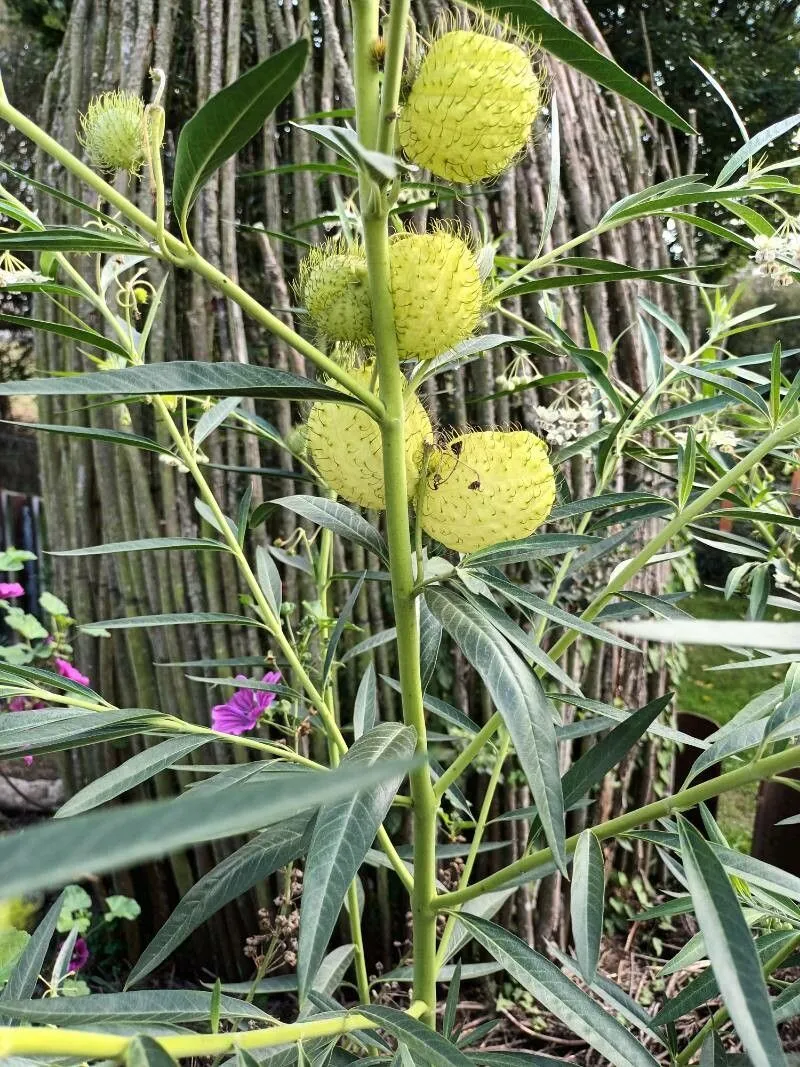
Author: E.Mey.
Bibliography: Comm. Pl. Afr. Austr.: 202 (1838)
Year: 1838
Status: accepted
Rank: species
Genus: Gomphocarpus
Vegetable: Unknown
Observations: S. Mozambique to S. Africa
Balloon cotton bush, scientifically known as Gomphocarpus physocarpus, is a fascinating plant native to regions extending from southern Mozambique to South Africa. This unique member of the Apocynaceae family can be recognized by its distinctive, balloon-like seed pods, which contribute to its common name.
This perennial shrub typically grows to a height of 1 to 2 meters, thriving particularly well in the warm climates of southern Africa. The plant features narrow, lance-shaped leaves arranged oppositely along its stems. These leaves are a vibrant green, creating a lush backdrop for the plant’s unique reproductive structures.
One of the most striking characteristics of the balloon cotton bush is its spherical fruiting bodies. These inflated pods, which can reach up to 8 centimeters in diameter, resemble small, green balloons covered in fine hairs. As they mature, they gradually turn brown and split open, releasing numerous seeds equipped with silky tufts. These tufts aid in the dispersal of seeds by the wind, ensuring the spread of the plant across its native range.
Flowering typically occurs from late summer to early autumn, producing clusters of small, white to pale pink flowers. Each flower is delicate and intricately structured, contributing to the plant’s ornamental appeal.
Apart from its unique visual traits, the balloon cotton bush also holds significance in various traditional practices. In some local cultures, it is used for medicinal purposes, with different parts of the plant believed to have therapeutic properties. However, caution is advised since parts of the plant can be toxic if ingested improperly.
E. Mey., the authority who first described this species in 1838 in “Comm. Pl. Afr. Austr.,” highlighted its unique characteristics and its importance to the floristic diversity of the African landscape. The adaptability and distinct features of the balloon cotton bush make it not only an interesting subject for botanical studies but also a valued addition to gardens and natural plantings in appropriate climates around the world.
In summary, Gomphocarpus physocarpus is a remarkable plant that captivates with its unusual fruiting structures and contributes to the ecological and cultural tapestry of southern Africa. Its adaptability and striking appearance ensure that it remains a plant of interest for botanists, horticulturists, and plant enthusiasts alike.
Eng: balloon cotton bush, balloon cottonbush, balloon plant, bladderbush, cottonbush, hairy balls, narrow-leaf cottonbush, swanplant, wild cotton
Deu: schwanen-seidenpflanze
Swe: monarkballongbuske
Por: paina-de-seda
En: Balloon cotton bush, Balloon cottonbush, Balloon plant, Bladderbush, Cottonbush, Hairy balls, Narrow-leaf cottonbush, Swanplant, Wild cotton
Fr: Ti-Ouete, Balloon Cottonbush
De: Schwanen-Seidenpflanze
Pt: Paina-de-seda
Sv: Monarkballongbuske
© copyright of the Board of Trustees of the Royal Botanic Gardens, Kew.
© copyright of the Board of Trustees of the Royal Botanic Gardens, Kew.
© copyright of the Board of Trustees of the Royal Botanic Gardens, Kew.
Taken Nov 16, 2022 by Olga Sukhova (cc-by-sa)
Taken Dec 4, 2020 by elena (cc-by-sa)
Taken Aug 30, 2022 by shahbanou (cc-by-sa)
Taken Dec 5, 2021 by M B (cc-by-sa)
Taken Feb 8, 2018 by Ian Clegg (cc-by-sa)
Taken May 3, 2017 by Rémi Knaff (cc-by-sa)
Taken May 3, 2017 by Rémi Knaff (cc-by-sa)
Taken May 3, 2017 by Rémi Knaff (cc-by-sa)
Taken May 3, 2017 by Rémi Knaff (cc-by-sa)
Taken May 3, 2017 by Rémi Knaff (cc-by-sa)
Taken Dec 29, 2019 by Paez Gabriel (cc-by-sa)
Taken Nov 3, 2022 by Didier Revillon (cc-by-sa)
Taken Nov 15, 2022 by Laurent Seychelles (cc-by-sa)
Taken May 10, 2019 by Martinez Correa Joaquin Rodrigo (cc-by-sa)
Taken Sep 1, 2016 by bas yves (cc-by-sa)
Taken Jul 8, 2022 by Monteiro Henrique (cc-by-sa)
Taken Feb 7, 2021 by Holy Dejeji (cc-by-sa)
Taken Aug 18, 2020 by Olivia Lebon (cc-by-sa)
Taken Sep 4, 2022 by Christine Sa (cc-by-sa)
Taken Sep 1, 2016 by bas yves (cc-by-sa)
Taken Nov 13, 2019 by philippe olczyk (cc-by-sa)
Taken Aug 25, 2019 by downe bob (cc-by-sa)
Taken Sep 5, 2018 by Carlos Miguel Fosquinha (cc-by-sa)
Taken Dec 20, 2019 by gladwin gladwin (cc-by-sa)
Taken Apr 17, 2020 by Eric McIlwain (cc-by-sa)
Taken Aug 22, 2021 by Monteiro Henrique (cc-by-sa)
Taken Jun 9, 2022 by Birgitta Tittel (cc-by-sa)
Taken Feb 4, 2022 by Dan Maxwell (cc-by-sa)
Taken Feb 4, 2022 by Monteiro Henrique (cc-by-sa)
Taken Nov 3, 2022 by Didier Revillon (cc-by-sa)
Family: Myrtaceae Author: (F.Muell.) K.D.Hill & L.A.S.Johnson Bibliography: Telopea 6: 402 (1995) Year: 1995 Status:…
Family: Rubiaceae Author: Pierre ex A.Froehner Bibliography: Notizbl. Bot. Gart. Berlin-Dahlem 1: 237 (1897) Year:…
Family: Sapindaceae Author: Koidz. Bibliography: J. Coll. Sci. Imp. Univ. Tokyo 32(1): 38 (1911) Year:…
Family: Asteraceae Author: A.Gray Bibliography: Pacif. Railr. Rep.: 107 (1857) Year: 1857 Status: accepted Rank:…
Family: Fabaceae Author: Medik. Bibliography: Vorles. Churpfälz. Phys.-Ökon. Ges. 2: 398 (1787) Year: 1787 Status:…
Family: Aspleniaceae Author: (Cav.) Alston Bibliography: Bull. Misc. Inform. Kew 1932: 309 (1932) Year: 1932…